One of the first water softeners we ever reviewed, the SpringWell SS Salt-Based Water Softener, continues to rank as one of our top 3 picks for salt-based water softeners today. But exactly why do we love it so much? And, importantly, what are its downfalls?
We’ve used the SpringWell SS in our testing location in the Rocky Mountains near Telluride, Colorado.
We tested the water softener’s ease of installation, ability to improve our water quality, reliability, and more. Find out whether it lived up to our high expectations in this review.
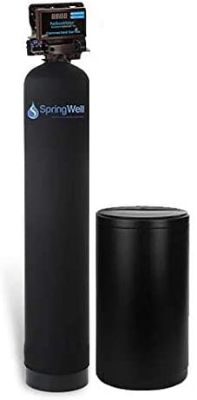
SpringWell SS Salt-Based Water Softener System is one of the most dependable and capable ion exchange water softeners currently on the market.
Table of Contents
🧾 Overview of the SpringWell Salt-Based Water Softener
The Springwell Salt-Based Water Softener is a salt-based water softener that uses the conventional ion exchange method to replace hard water minerals with sodium ions. This eliminates limescale and removes existing scale in pipes and fixtures.
The water softener is a point-of-entry system that treats your water before it can travel around your plumbing.
The idea is that hard water flows straight into the system when it enters your home. Here, the hardness ions are removed, so the water that’s supplied to your home is soft and unable to damage your pipes and appliances.
We had the choice of three salt-based water softeners in the SS series:
- The 11 GPM SS1, for homes with 1-3 bathrooms
- The 13 GPM SS4, for homes with 4-6 bathrooms
- The 20 GPM SS+, for commercial use
There’s no difference in the quality of water softening between these water softeners – all three use the exact same softening process, and all three are made from certified, durable components.
The only difference is size and flow rate. Most folks should be fine to go with the SS1, but you might need to upgrade based on your water usage (drinking water and appliance usage) and household size.
SpringWell offers a leading limited lifetime warranty and a 6-month money-back satisfaction guarantee for all its products, including the SS series. We felt reassured knowing that our purchase was protected if we ever encountered a design fault – and we could return the softener within 6 months if we didn’t love it within this testing period.

Our readers get 5% off at springwellwater.com – 👉 Click here to get your coupon.
In our testing, the SpringWell SS stood out for reducing our water hardness by 97.5% – one of the best reductions we’ve ever seen in a water softener we’ve tested. We noted that the softener gave us a reliable, easy way to access soft water around our entire home. We detected no new limescale formation during our 6-month trial period. However, we did come across some issues during the install process, and it’s not the cheapest water softener we’ve used.
👍 What I Like
- Reduced more than 97% of water hardness in our testing
- Also removes existing limescale
- Sturdy, durable design
- Uses certified components
- Intuitive regeneration technology helps reduce salt top-ups & water waste
👎 What I Don’t Like
- Expensive
- Install process is complex
- Not suitable for rentals
- No sediment pre-filter included
💡 First Impressions
Our first impression of the SpringWell SS was that it’s a bit more expensive than the similar salt-based water softeners we’ve tested. The smallest model cost around $1,530 at the time of our review, which is around $200-$300 costlier than many of its competitors.
In the package we received, the following components were for the SS water softener:
- The main resin tank, pre-loaded with resin, including the tank cap, distributor tube, and tank sleeve
- The brine tank, containing the parts and the electronic control head
- A 50-inch drain line
- A hose clamp
The tanks are made from polypropylene, a lightweight, durable, corrosion-resistant material that’s used in plastic furniture, vehicles, and machinery, and is also used effectively for strengthening concrete.
The SS system is big, bulky, and heavy, owing to the large size of the tanks and the weight of the pre-loaded resin in the media tank. We needed two people to carry the box to our intended install location.
Getting started was pretty time-consuming because the system needed to be installed at our water line before it could be used.
We noted a few features of the system that would make it easier for us to use and monitor the SS system.
The key feature was a Bluetooth app connection, which meant we could view all the data on our water softener’s control head via an app on our phones.
That said, we can see how for some folks it might seem unnecessary or difficult to use, or might prefer to manually set the regeneration cycles.
In all, we were pleased with the quality of the look and feel of the SpringWell SS, although it is heavy and bulky, and the installation process was complex.
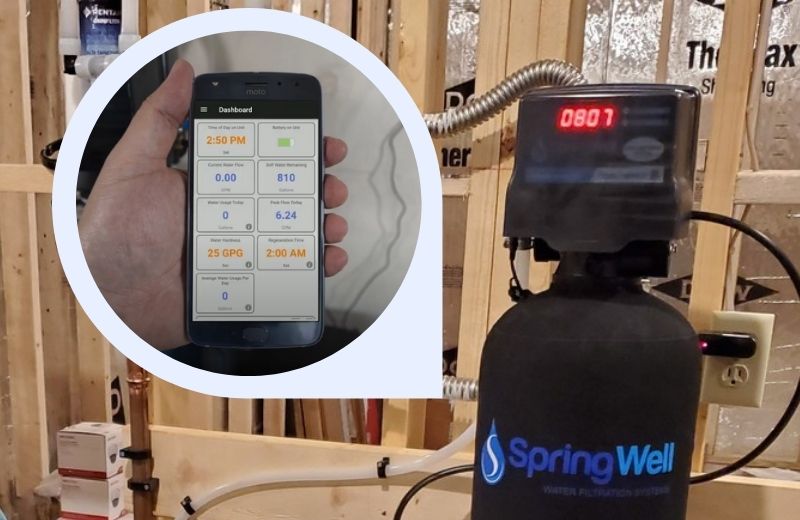
🧪 Performance Testing Data
Given that it’s a salt-based water softener using the proven ion exchange water softening method, we expected that the SpringWell SS would soften our water.
However, there’s no testing data on the SpringWell website that says exactly what percentage of hardness minerals the system can remove.
We like to see stats to support a manufacturer’s performance claims. So, it was especially important that we tested the water softener ourselves, to see how it performed when treating our own water supply in Colorado.
We used Tap Score to test our untreated and softened water samples. Tap Score provided us with a test kit, which came with instructions that we followed carefully to take our samples. We then returned our samples to Tap Score’s lab to be professionally tested.

We took two samples from the same kitchen faucet for each test:
- Our first-draw sample was taken in the morning after our water had sat in the pipes overnight. This was to determine how the water interacted with our plumbing.
- Our second sample was taken after we’d left the faucet running for 5 minutes to flush the pipes, which helped us to determine the quality of our water without influence from our home’s plumbing.
We conducted the first test on November 26, 2022, then installed the system on January 18, 2023, and conducted our second test on March 3, 2023. We received our test results via email within 5 days of shipping them to the lab.
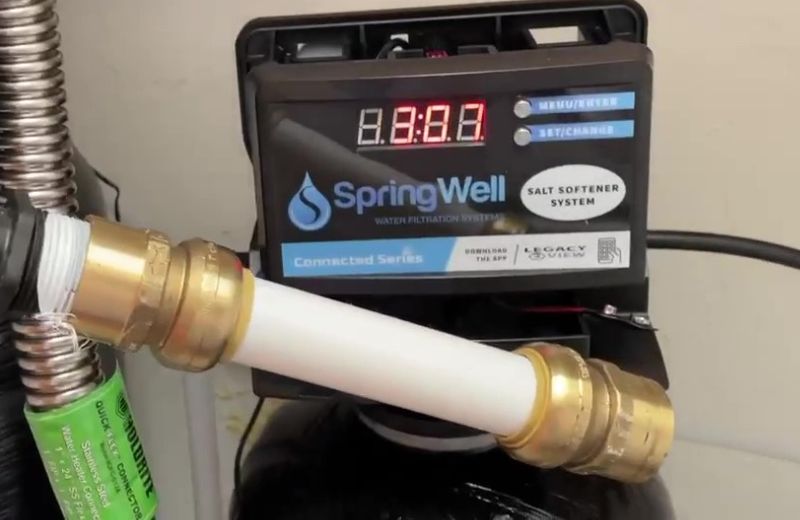
Water Hardness Reduction
Our sole purpose in installing the SpringWell SS was to soften our water. Our feed water supply is groundwater from a shared well, which is hard – our pre-treatment water sample contained 13.71 grains per gallon of hardness. For reference, 7.1-17.5 GPG of water hardness puts water in the “hard” category.
We were really pleased to see that in our post-filtration sample, only 0.34 GPG of water hardness was detected, meaning that the SS water softener had effectively reduced 97.5% of calcium and magnesium hardness ions.

That was exactly what we’d expected to see from a system that uses a water treatment process that’s known to be consistently reliable.
🧪 Our Testing
Our test results said everything we needed to know about the SpringWell SS’s ability to soften our water – but we wanted to look beyond the numbers to see how the SpringWell SS performed on the whole.
We wanted to test the SS for a few specific performance factors, including how it affected our water flow, whether there were any noticeable water quality changes, and its overall performance efficiency.
We’ve discussed these factors in detail in the below sections.
Changes to Our Water Quality
First, we were keen to evaluate whether the SpringWell SS had any effect on our water quality, good or bad.
The biggest difference that we noticed right away was that our water had a different feel. Salt-softened water has a smooth, silky, slippery texture, which can take a while to get used to if you’re familiar with the stickiness of hard water!
We noticed that we could use less soap and shampoo to achieve a lather when we were showering and washing our hands and dishes. This was because our water no longer contained scale-causing calcium and magnesium minerals.
Taste-wise, we did notice a subtle change due to the loss of minerals. But our water pH wasn’t reduced at all – in fact, it actually increased by around 4% post-treatment – so there were no issues with acidity.
We couldn’t detect any sodium taste, as expected. If you can taste sodium in your softened water, you’re probably overdosing your water with salt.
Scale Formation
We also wanted to monitor the SpringWell SS throughout our testing period to see if any new limescale was formed after installing the system.
To ensure accurate monitoring, we used an industry-standard descaling cleaner on our testing locations, including the underside of our shower head, our kitchen faucet, and our toilet bowl, to remove the existing scale before we conducted the testing.
We then installed the SS, and examined these locations every 4 weeks to check for new scale formation.
In all the testing locations, we spotted no obvious limescale throughout our 6-month testing period. That meant the SS was consistently providing calcium-free soft water throughout our home, which no longer had scale-forming properties.
Changes to Our Water Flow
We know that flow rate is especially important when installing a point-of-entry water treatment system like a whole-house water softener. This type of system intercepts your water line and has the potential to affect the flow of water throughout your whole home.
We installed the smallest model in the SS series, the SpringWell SS1. The starting flow rate for this system is 11 GPM – higher than the average starting flow rate of 6-7 GPM in the other base-model water softeners we’ve tested.
We didn’t notice a difference in the speed of water from our faucets, or our water pressure in general, after installing the unit. We could still use our appliances and fixtures as normal.
We’re actually hopeful that the SpringWell SS will improve our water flow and pressure. Because our initial water hardness was so high, we think it’s likely that our plumbing is affected by an extreme amount of scale buildup, especially in our home’s hot water lines.
Our water pressure was low before we installed the SS, and we expect that the softener should break down the existing limescale in our plumbing. This should take care of the low water pressure issue over time.
Performance Efficiency
There weren’t many ways that we could monitor the performance efficiency of the SpringWell SS, and we mostly had to go off SpringWell’s marketing.
The SS uses demand-initiated regeneration, which means it only regenerates once the softening resin reaches the end of its usefulness. That makes it more efficient than timer-based water softeners, which regenerate according to a set schedule, meaning that they often regenerate when the softening resin still contains sodium.
The fact that the SS is demand-initiated meant that we were using less water and wasting less salt because the system was only regenerating when absolutely necessary.
We downloaded the SpringWell app and used it to monitor and control our system. We could use the app to schedule regeneration cycles remotely at any time, and being able to monitor the system from the app enabled us to better understand how it worked, so we could make decisions to improve efficiency and save money in the long run.
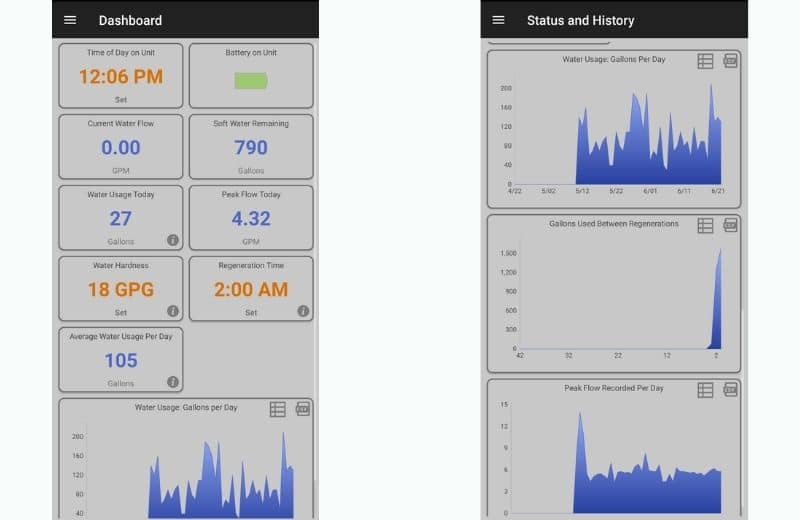
Limiting Factors
Finally, there are a few limiting factors that we think are important to mention in this performance section.
The first is that, unlike many of the other salt-based water softeners we’ve tested, the SpringWell SS doesn’t come with a sediment filter. That meant we’d have to buy one separately if we wanted to protect the softening resin from sediment, which could cause damage that shortens the resin’s lifespan.
We especially recommend installing your own sediment pre-filter if, like our test water, you’re on a well water supply. City water is typically sediment-free, but well water often contains sand, silt, and other sediment. SpringWell sells a sediment filter, but at an extra cost.

Another limiting factor is, as with all salt-based water softeners, certain contaminants in our feed water had the potential to affect the resin’s softening performance and longevity.
Our water contained iron, which we removed with the AIO system that came in the WSS package. But if you buy the SS alone, keep in mind that high iron levels in your feed water can foul or damage the resin, and most manufacturers will strongly recommend pre-filtration.
Chlorine is another contaminant that can damage a water softener’s resin, but the resin in the SS softener is supposedly chlorine-resistant. So, you shouldn’t have to worry about this if you have normal levels of chlorine in your water.
📑 Softener Testing & Certifications
As far as we can tell, the SpringWell SS has no available third-party test results to view online, and the system hasn’t been officially performance certified.
This is one of the biggest setbacks of this SpringWell model for us. We would have loved to see, at the very least, testing to NSF Standard 44, for cation exchange water softeners (like the SS). SpringWell is a trusted brand with a long history and a good reputation in the industry, but testing or certifications would have provided additional reassurance of the SS’s performance.
We do know that the softener’s components are certified, so that’s something at least.
🔧Installation & Maintenance Considerations
Like all Springwell systems, the SpringWell SS1 is designed to be installed by the homeowner. The job involves cutting through your water pipe, upstream of your water heater so you’ll need some basic plumbing understanding.
If you’re a handy person, you’ll be able to install the Springwell softener in roughly 4 hours.
Anyone who doesn’t feel confident in their plumbing abilities would be better off hiring an expert plumber for installation, which will add around $200-$400 to the initial price tag. We personally chose to get the SS installed by a professional for peace of mind.
There were a few setbacks we identified with the installation process:
- Not all the parts we needed were included for our specific/unique installation (the SS softener and AIO system).
- The included fittings were plastic and weren’t as durable as they could have been. Our plumber recommended that we upgraded to brass fittings from the hardware store, so this is what we did.
- There was a bit of leaking from the gasket when our plumber installed it – it was loose and was luckily easy to tighten.
- The installation instructions and images didn’t provide a complete walkthrough. Our plumber had to contact tech support with a few specific questions. Not all support staff were super helpful.
In terms of maintenance, we had to replenish the sodium levels in the brine tank every 4 weeks or so. A bag of salt costs anywhere from $10 to $50, depending on the type, brand, and quality.
In case you’re pretty new to salt-based softeners, you should know that the Springwell SS uses ion exchange to soften water, which means it requires salt to operate.
The salt gets transported into the resin, and it’s released into the water to soften it. Once all the salt has run out, the softener regenerates, drawing brine (a salty water solution) from the brine tank. Since a water softener can only work with salt, we had to replenish the brine tank to keep it nicely stocked up.
The brine tank in the SS1 can hold more than 200 lbs of salt, and we found it easy to load with its wide mouth. We could use potassium chloride instead of salt if we preferred, as a no-salt alternative. However, we had to increase the softener valve’s salt dosage program setting by about 10% because slightly more potassium chloride is needed to have the same softening effects as sodium.
The softening resin will last around 8 years before it needs to be replaced, so this isn’t something we had to think about. It’s a premium 10% cross-link resin, which we were pleased to see – mostly, manufacturers cheap out by pre-filling their softeners with a less durable 8% cross-link.
In terms of ongoing costs, the system slightly increased our electricity bill but it was never more than about $10 or so a month. Our system regenerates about once a week, which adds about 400 gallons to our water bill each month. The exact frequency of regeneration depends on your water usage and hardness.
Here’s the user manual, containing instructions for the SS1, the SS4, and the SS+: https://www.springwellwater.com/wp-content/uploads/2020/01/SS1_SS4-Installation-Instructions.pdf
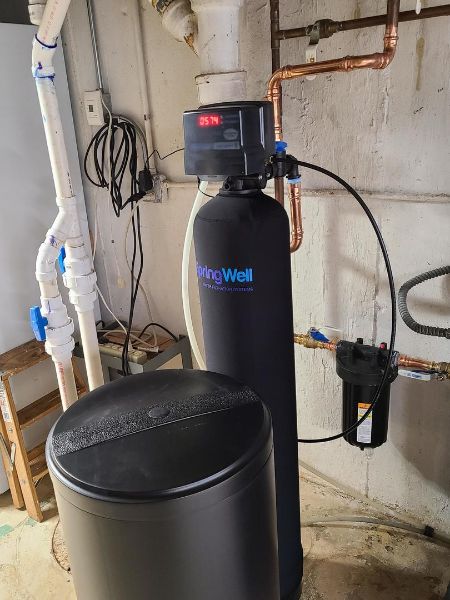
Our readers get 5% off at springwellwater.com – 👉 Click here to get your coupon.
🤔 Is The SpringWell SS Right for You?
In our opinion, the SpringWell SS is the best water softener for anyone who’s specifically looking for a conventional salt-using water softener that delivers consistent soft water benefits.
It’s a great choice for folks who want to properly soften their entire home’s water supply in the traditional sense by removing calcium and magnesium minerals.
However, we don’t recommend the SpringWell SS Water Softener if you don’t want the hassle of topping up a brine tank or you’re looking for a scale prevention solution that’s easier to install.
Plus, make sure to check out your local regulations. Ion exchange water softeners like the SS are banned in some parts of the country.
If you just want to prevent scale without actually removing hardness minerals, our tip is to go for a salt-free water conditioner, such as a template-assisted crystallization conditioner.
If you want a scale reduction system that’s really easy to install and you only have moderately hard water, you can also consider electromagnetic water descalers.

Our readers get 5% off at springwellwater.com – 👉 Click here to get your coupon.
Found this review helpful?
Comment below or share this article!
More Reviews:
- Looking for the crème de la crème of water softeners? We compare the top systems in 2024 here.
- Learn about SpringWell’s water filtration systems
- SpringWell Futuresoft Water Conditioner Review (2024)

